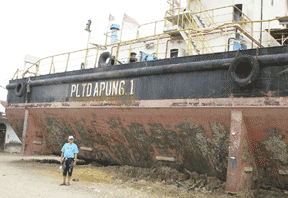 |
||||||||||
|
||||||||||
|
||||||||||
Changing Latitudes, Changing AttitudesIn the tsunami’s wakeBanda Aceh, Indonesia: Latitude 05.35 N; Longitude 95.20 E by Dick Wilson
|
||||||||||
 |
A memorial marks the dead. In less than two hours, The tsunami killed more than 130,000 people in the city of Banda Aceh, Indonesia. |
 |
The awesome power of the tsunami left many visible signs. As the water moved inland, it was funneled into narrow valleys, further concentrating its force. The side of a ridge several miles from shore is swept clean of all vegetation up to a height of at least 100 feet. Stumps of palm trees stick from barren ground where once grew lush vegetation.
But the most dramatic example, perhaps, is a huge ocean-going barge that now rests in the middle of a residential inland neighborhood. This is more than a boat; it’s a ship weighing many tons. The wave lifted the barge from the harbor, carried it over the tops of houses and dropped it more than three miles from shore in a residential neighborhood. Houses and people were crushed; they remain under the barge. Now the vessel houses the city’s power distribution system, which is fitting since it also serves as a stark reminder of the raw power of nature.
Many children died in the tsunami, and it’s a rare Acehnese family that did not lose at least one little one. Like other Indonesians, Acehnese families tend to have several generations — grandparents, parents, children and children’s children (and maybe some cousins) — living under one roof. So children weren’t the only victims. Many families lost as many as 20 family members.
Now, 27 months after the disaster, we expected to find a place engulfed in mourning. But such was not the case; the people we met showed no overt signs of grief. They freely discussed the tsunami and its aftermath without visible signs of emotion, and they seem to have an inner strength that may derive from the fact that everyone in the city shares the same anguish; no one escaped scot-free.
“It’s all right,” an oil worker told me. “It’s in the hands of God.”
Seeking to Rise
Aside from the toll in human lives, the tsunami caused huge social and legal problems. Property lines were wiped out, opening the door for monumental legal claims. What was once prime beachfront property is now underwater. And the property damage extends several miles inland. People who once owned property now have no way to know where their property is — or was. All government records were swept away by the water, and there are few geographical features left to help locate property lines. The city is full of gutted ruins and free-standing walls that were once parts of houses, but the owners have no way to prove ownership, which is what the government requires before a house can be rebuilt.
Housing for the surviving population was (and probably still is) the most urgent problem in the flood’s aftermath, and many governments (including the U.S.) and non-government organizations responded to the need.
The Indonesian government set rules on new construction and established a bureaucracy that sometimes hindered as much as it helped. One of the rules is that new houses must not be more than 36 square meters (a little more than 1,000 square feet). It’s a realistic response to a situation involving hundreds of thousands of newly homeless people, but many find the policy difficult to accept. Someone whose large family may have once resided comfortably in a 20-room mansion is now stuck with 36 square meters.
Numerous problems have arisen with the construction of the new houses. Many (maybe most) of the homes built soon after the flood were erected in haste, and now they’re crumbling. But there’s no one to blame; a large sector of the population was homeless, and aid groups were responding to the urgent need as quickly as possible.
Aceh is rich in natural resources, including oil. The province occupies a unique niche in Indonesia. Ninety-five percent Muslim, they fought a low-scale guerilla war for many years against the Indonesian government to gain their independence. Prior to the tsunami, they wanted no contaminating influences from outside and discouraged tourism.
Everything changed after the tsunami. The Acehnese realized after the disaster that they had to rely on help from outside. Now, everyone is welcome in Aceh, although political problems still persist.
Remember the 83-year-old lady who was saved by a tree? She told me that the tsunami “has changed everything for the better.”
Imagine that.
• • •
I can only report our own experience with the Acehnese: We found them to be warm and friendly, just like all other Indonesians we met. I wouldn’t recommend Aceh as a tourist destination, but I’m glad we were there. During our five-day sojourn in Aceh, we encountered only kindness, courtesy and respect. I will reciprocate in kind when we return in 2008.
For now I’ll just sit and relax on our serene Chesapeake shore — but I’ll never forget that things can change in an instant.
|
Current Issue \\ Archives \\ Subscriptions \\ Clasified Advertising \\ Display Advertising |
© COPYRIGHT 2007 by New Bay Enterprises, Inc. All rights reserved.
